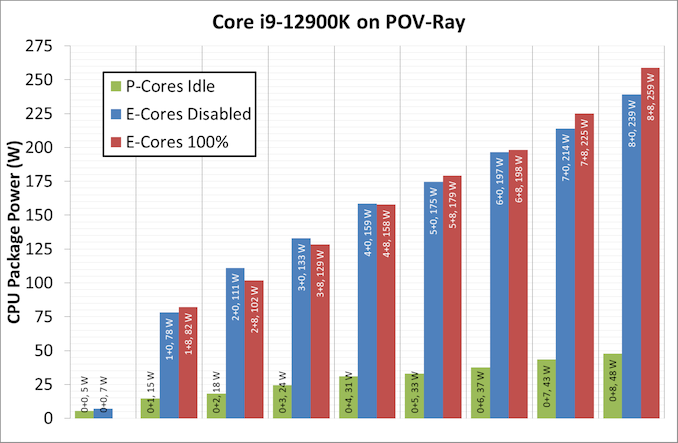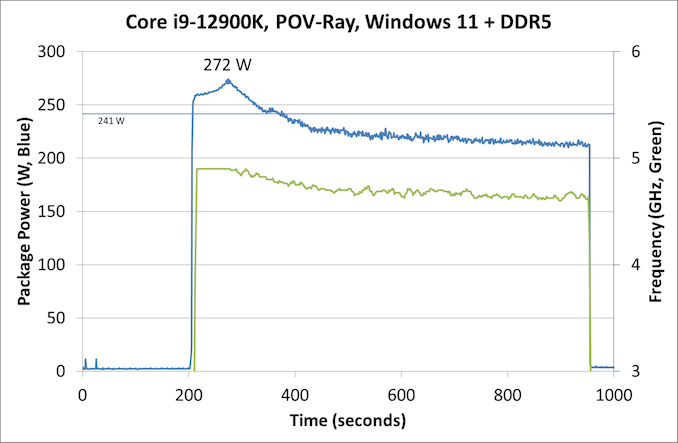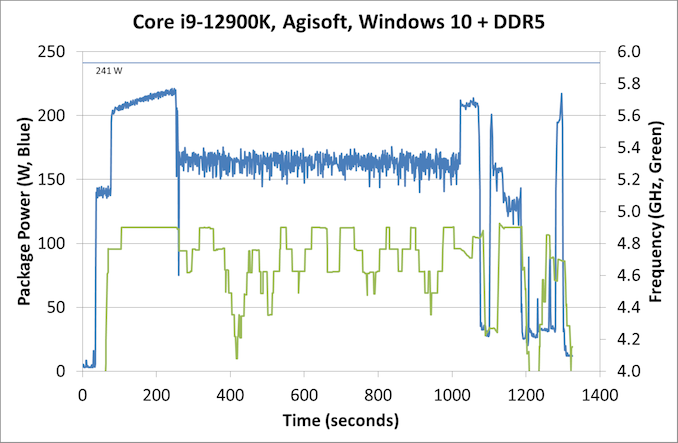The Intel 12th Gen Core i9-12900K Review: Hybrid Performance Brings Hybrid Complexity
by Dr. Ian Cutress & Andrei Frumusanu on November 4, 2021 9:00 AM ESTPower: P-Core vs E-Core, Win10 vs Win11
For Alder Lake, Intel brings two new things into the mix when we start talking about power.
First is what we’ve already talked about, the new P-core and E-core, each with different levels of performance per watt and targeted at different sorts of workloads. While the P-cores are expected to mimic previous generations of Intel processors, the E-cores should offer an interesting look into how low power operation might work on these systems and in future mobile systems.
The second element is how Intel is describing power. Rather than simply quote a ‘TDP’, or Thermal Design Power, Intel has decided (with much rejoicing) to start putting two numbers next to each processor, one for the base processor power and one for maximum turbo processor power, which we’ll call Base and Turbo. The idea is that the Base power mimics the TDP value we had before – it’s the power at which the all-core base frequency is guaranteed to. The Turbo power indicates the highest power level that should be observed in normal power virus (usually defined as something causing 90-95% of the CPU to continually switch) situation. There is usually a weighted time factor that limits how long a processor can remain in its Turbo state for slowly reeling back, but for the K processors Intel has made that time factor effectively infinite – with the right cooling, these processors should be able to use their Turbo power all day, all week, and all year.
So with that in mind, let’s start simply looking at the individual P-cores and E-cores.
Listed in red, in this test, all 8P+8E cores fully loaded (on DDR5), we get a CPU package power of 259 W. The progression from idle to load is steady, although there is a big jump from idle to single core. When one core is loaded, we go from 7 W to 78 W, which is a big 71 W jump. Because this is package power (the output for core power had some issues), this does include firing up the ring, the L3 cache, and the DRAM controller, but even if that makes 20% of the difference, we’re still looking at ~55-60 W enabled for a single core. By comparison, for our single thread SPEC power testing on Linux, we see a more modest 25-30W per core, which we put down to POV-Ray’s instruction density.
By contrast, in green, the E-cores only jump from 5 W to 15 W when a single core is active, and that is the same number as we see on SPEC power testing. Using all the E-cores, at 3.9 GHz, brings the package power up to 48 W total.
It is worth noting that there are differences between the blue bars (P-cores only) and the red bars (all cores, with E-cores loaded all the time), and that sometimes the blue bar consumes more power than the red bar. Our blue bar tests were done with E-cores disabled in the BIOS, which means that there might be more leeway in balancing a workload across a smaller number of cores, allowing for higher power. However as everything ramps up, the advantage swings the other way it seems. It’s a bit odd to see this behavior.
Moving on to individual testing, and here’s a look at a power trace of POV-Ray in Windows 11:
Here we’re seeing a higher spike in power, up to 272 W now, with the system at 4.9 GHz all-core. Interestingly enough, we see a decrease of power through the 241 W Turbo Power limit, and it settles around 225 W, with the reported frequency actually dropping to between 4.7-4.8 GHz instead. Technically this all-core is meant to take into account some of the E-cores, so this might be a case of the workload distributing itself and finding the best performance/power point when it comes to instruction mix, cache mix, and IO requirements. However, it takes a good 3-5 minutes to get there, if that’s the case.
Intrigued by this, I looked at how some of our other tests did between different operating systems. Enter Agisoft:
Between Windows 10 and Windows 11, the traces look near identical. The actual run time was 5 seconds faster on Windows 11 out of 20 minutes, so 0.4% faster, which we would consider run-to-run variation. The peaks and spikes look barely higher in Windows 11, and the frequency trace in Windows 11 looks a little more consistent, but overall they’re practically the same.
For our usual power graphs, we get something like this, and we’ll also add in the AVX-512 numbers from that page:

Compared to Intel’s previous 11th Generation Processor, the Alder Lake Core i9 uses more power during AVX2, but is actually lower in AVX-512. The difficulty of presenting this graph in the future is based on those E-cores; they're more efficient, and as you’ll see in the results later. Even on AVX-512, Alder Lake pulls out a performance lead using 50 W fewer than 11th Gen.
When we compare it to AMD however, with that 142 W PPT limit that AMD has, Intel is often trailing at a 20-70 W deficit when we’re looking at full load efficiency. That being said, Intel is likely going to argue that in mixed workloads, such as two software programs running where something is on the E-cores, it wants to be the more efficient design.














474 Comments
View All Comments
michael2k - Thursday, November 4, 2021 - link
One is a bellwether for the other.Mobile parts will have cores and clocks slashed to hit mobile power levels; 7W-45W with 2p2e - 6p8e
However, given that a single P core in the desktop variant can burn 78W in POV Ray, and they want 6 of them in a mobile part under 45W, that means a lot of restrictions apply.
Even 8 E cores, per this review, clock in at 48W!
That suggests a 6p8e part can't be anywhere near the desktop part's 5.2GHz/3.9GHz Turbo clocks. If there is a linear power-clock relationship (no change in voltage) then 8 E cores at 3GHz will be the norm. 6 P cores on POV-Ray burn 197W, then to hit 45W would mean throttling all 6 cores to 1.2GHz
https://hothardware.com/news/intel-alder-lake-p-mo...
siuol11 - Thursday, November 4, 2021 - link
Except that we know that the power-clock ratio is not linear and never has been. You can drop a few hundred MHz off of any Intel chip for the past 5 generations and get a much better performance per watt ratio. This is why mobile chips don't lose a lot of MHz compared to desktop chips.michael2k - Thursday, November 4, 2021 - link
We already know their existing Ice Lake 10nm 4C mobile parts are capped at 1.2GHz to hit 10W:https://www.anandtech.com/show/15657/intels-new-si...
A 6p8e part might not clock that low, but I'm certain that they will have to for the theoretical 7W parts.
Here's a better 10nm data point showing off their 15W-28W designs:
https://www.anandtech.com/show/14664/testing-intel...
4C 2.3GHz 28W TDP
Suggests that a 4pNe part might be similar while the 6p8e part would probably be a 2.3GHz part that could turbo up to a single core to 4GHz or all cores to 3.6GHz
TheinsanegamerN - Thursday, November 4, 2021 - link
Yes, once it gets in the way of performance, and intel's horrible efficiency means you need high end water cooling to keep it running, whereas AMD does not. Intel's inneficiency is going to be an issue for those who like air cooling, which is a lot of the market.Wrs - Thursday, November 4, 2021 - link
Trouble is I'm not seeing "horrible efficiency" in these benchmarks. The 12900k is merely pushed far up the curve in some of these benches - if the Zen3 parts could be pushed that far up, efficiency would likewise drop quite a bit faster than performance goes up. Some people already do that. PBO on the 5900x does up to about 220W (varies on the cooler).jerrylzy - Friday, November 5, 2021 - link
PBO is garbage. You can restrict EDC to 140A, let loose other restrictions and achieve a better performance than setting EDC to 220A.Spunjji - Friday, November 5, 2021 - link
"if the Zen3 parts could be pushed that far up"But you wouldn't, because you'd get barely any more performance for increased power draw. This is a decision Intel made for the default shipping configuration and it needs to be acknowledged as such.
Wrs - Saturday, November 6, 2021 - link
As a typical purchaser of K chips the default shipping configuration holds rather little weight. A single BIOS switch (PBO on AMD, MTP on Intel), or one slight change to Windows power settings, is pretty much all the efficiency difference between 5950x and 12900k. It pains me every time I see a reviewer or reader fail to realize that. The chips trade blows on the various benches because they're so similar in efficiency, yet each by their design has strong advantages in certain commonplace scenarios.Spunjji - Friday, November 5, 2021 - link
If the competition are able to offer similar performance and you don't have to shell out the cash and space for a 360mm AIO to get it, that's a relevant advantage. If those things don't bother you then it's fine, though - but we're in a situation where AMD's best is much more power efficient than Intel's at full load, albeit Intel appears to reverse that at lower loads.geoxile - Thursday, November 4, 2021 - link
Clock/power scales geometrically. The 5900HS retains ~85% of the 5800X's performance while using 35-40W stable power vs 110-120W for the 5800X. That's almost 3x more efficient. Intel is clocking desktop ADL to the moon, it doesn't mean ADL is going to scale down poorly, if anything I expect it to scale down very well since the E-cores are very performant while using a fraction of the power and according to Intel can operate at lower voltages than the P-cores can, so they can scale down even lower than big cores like ADL P-cores and zen 3. ADL mobile should be way more interesting than ADL desktop.